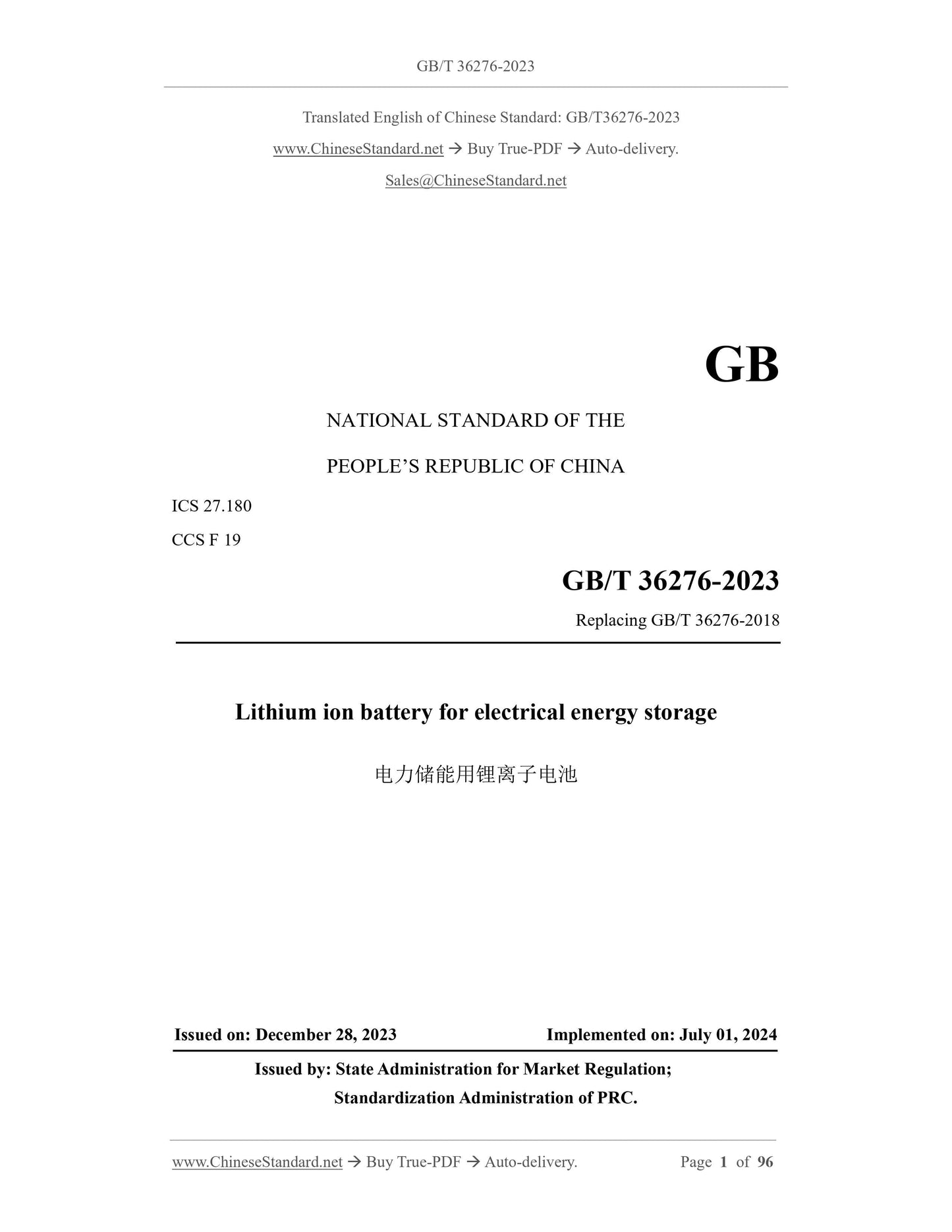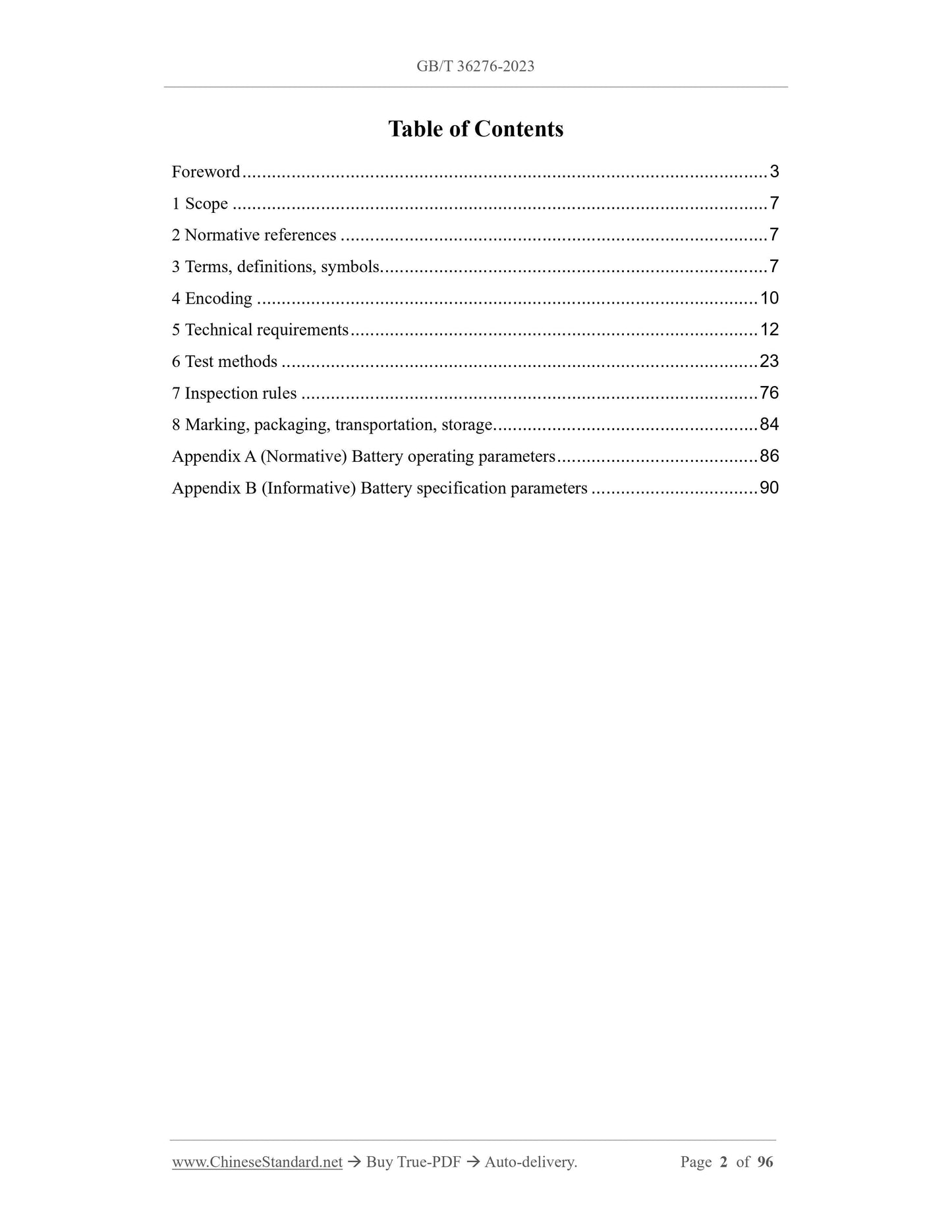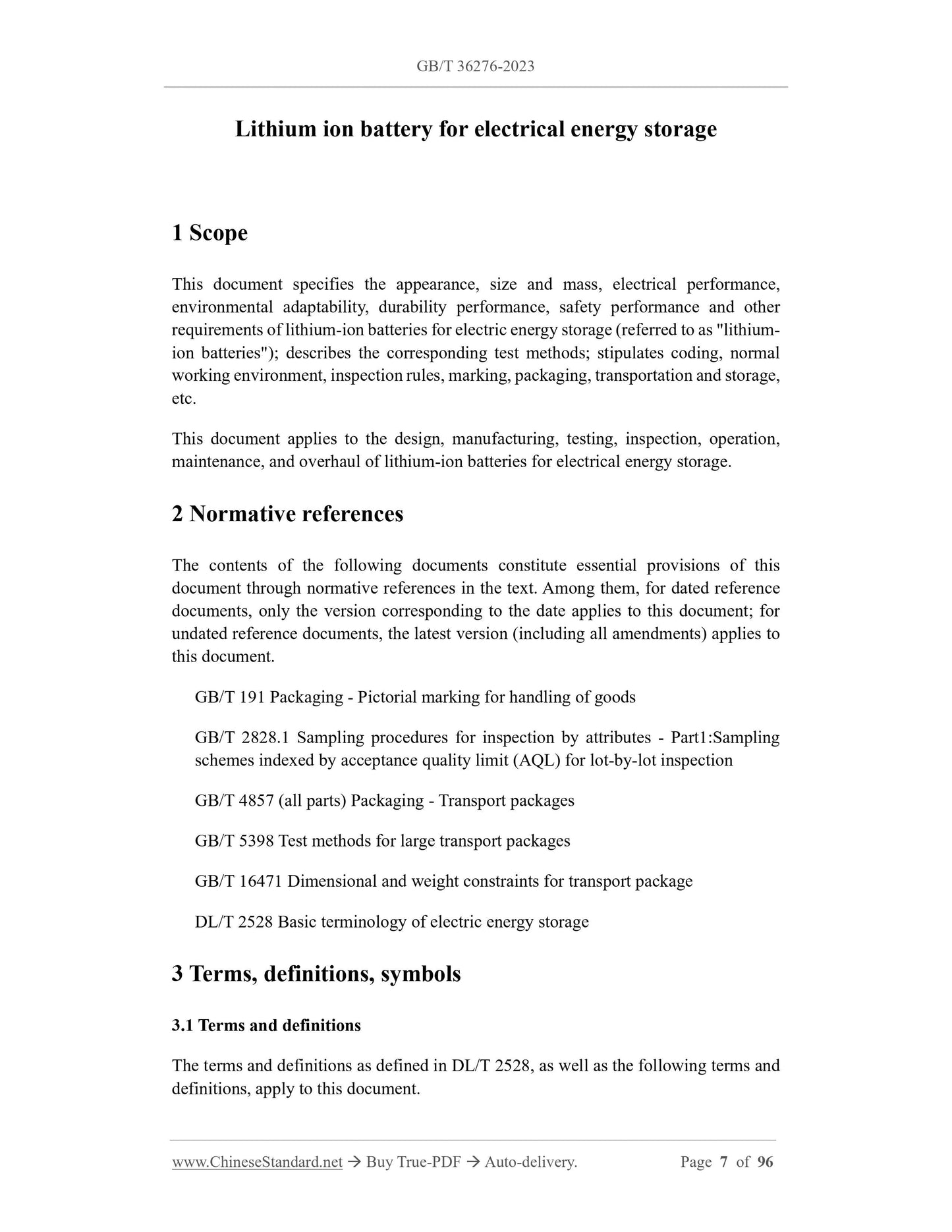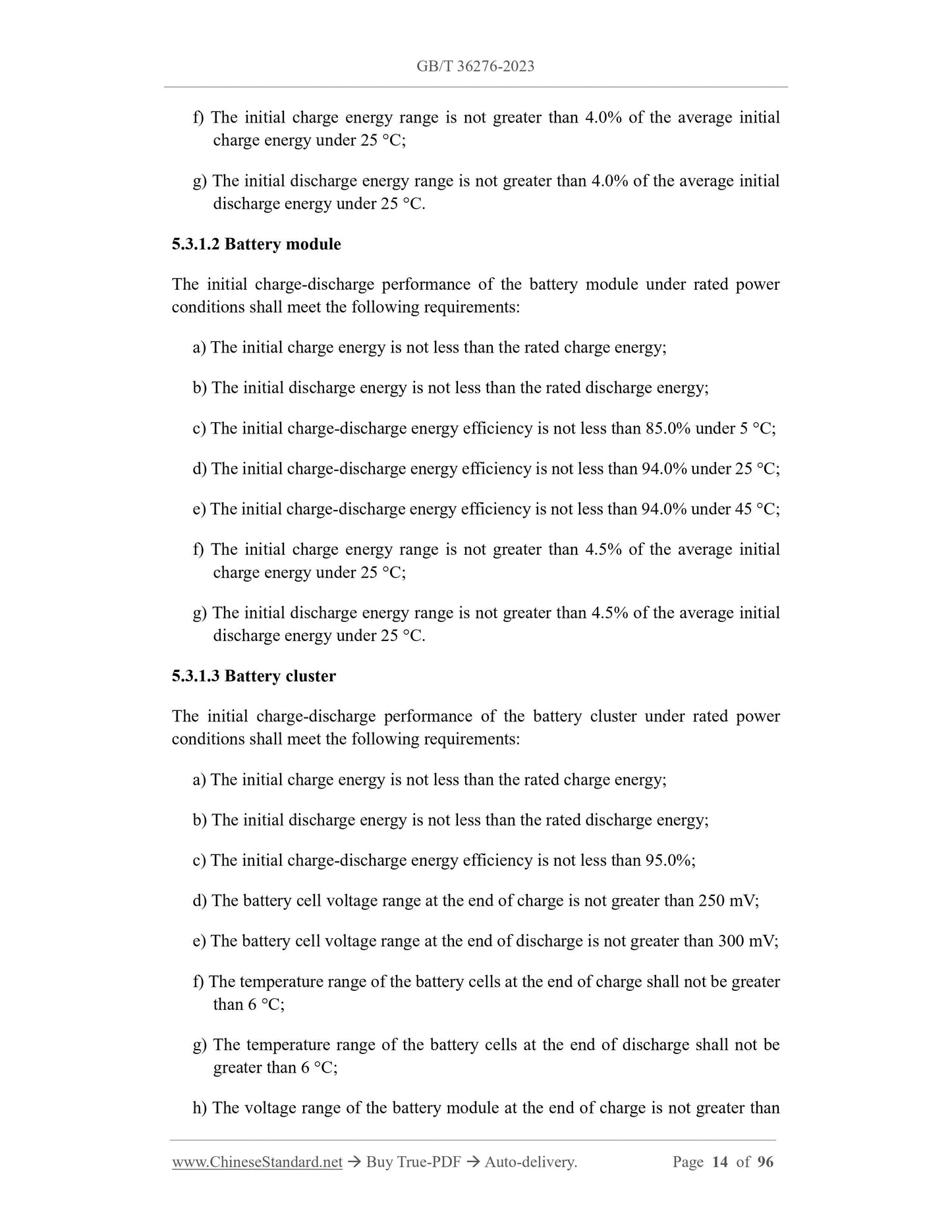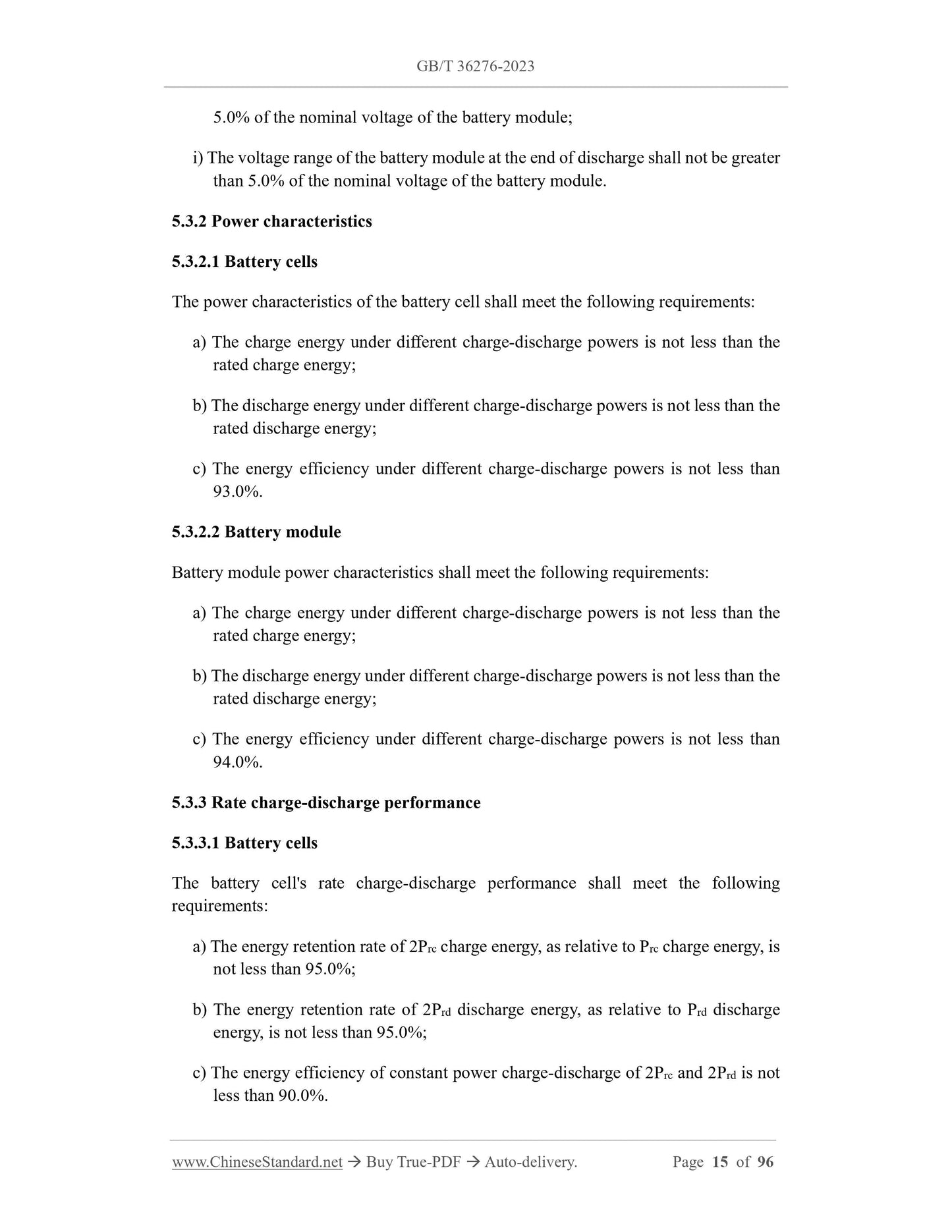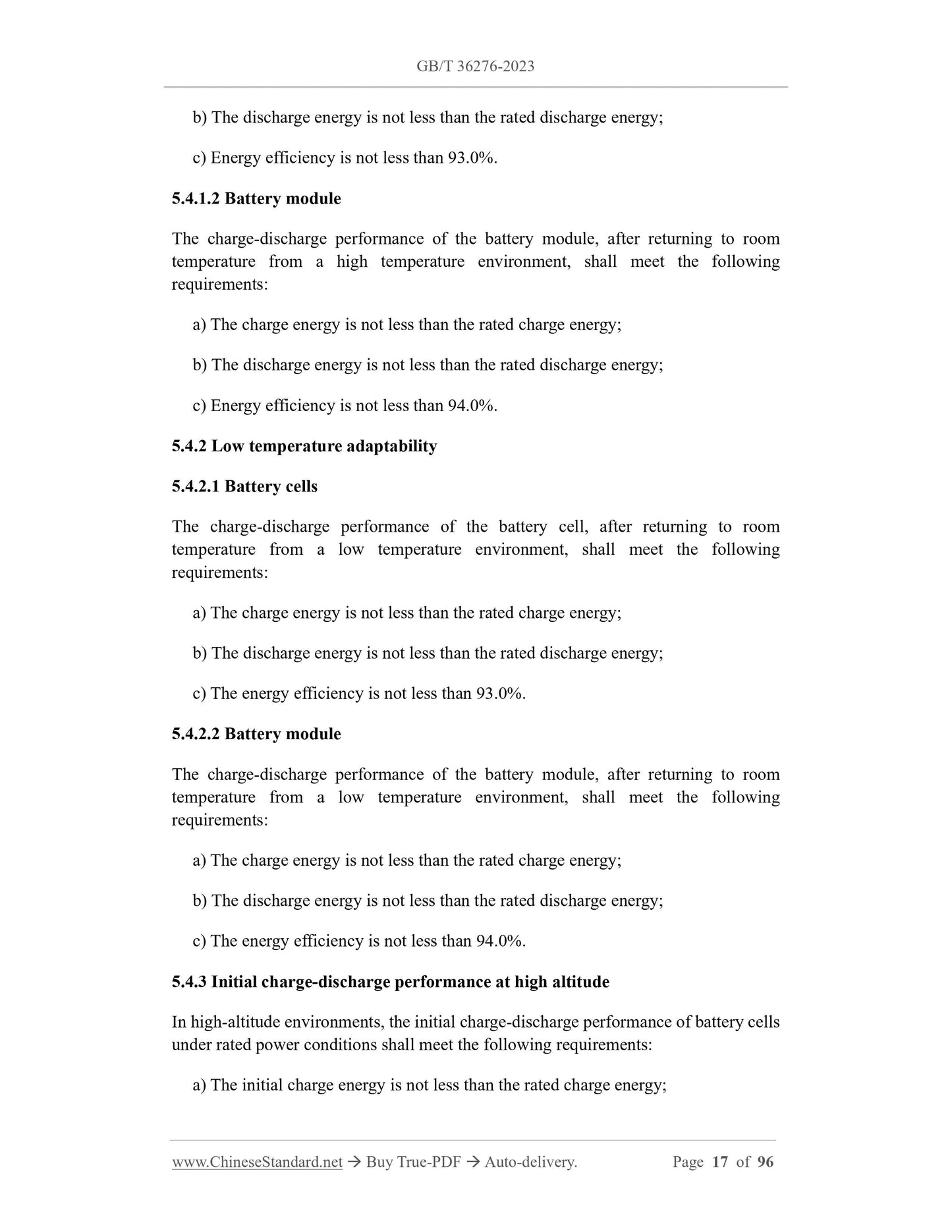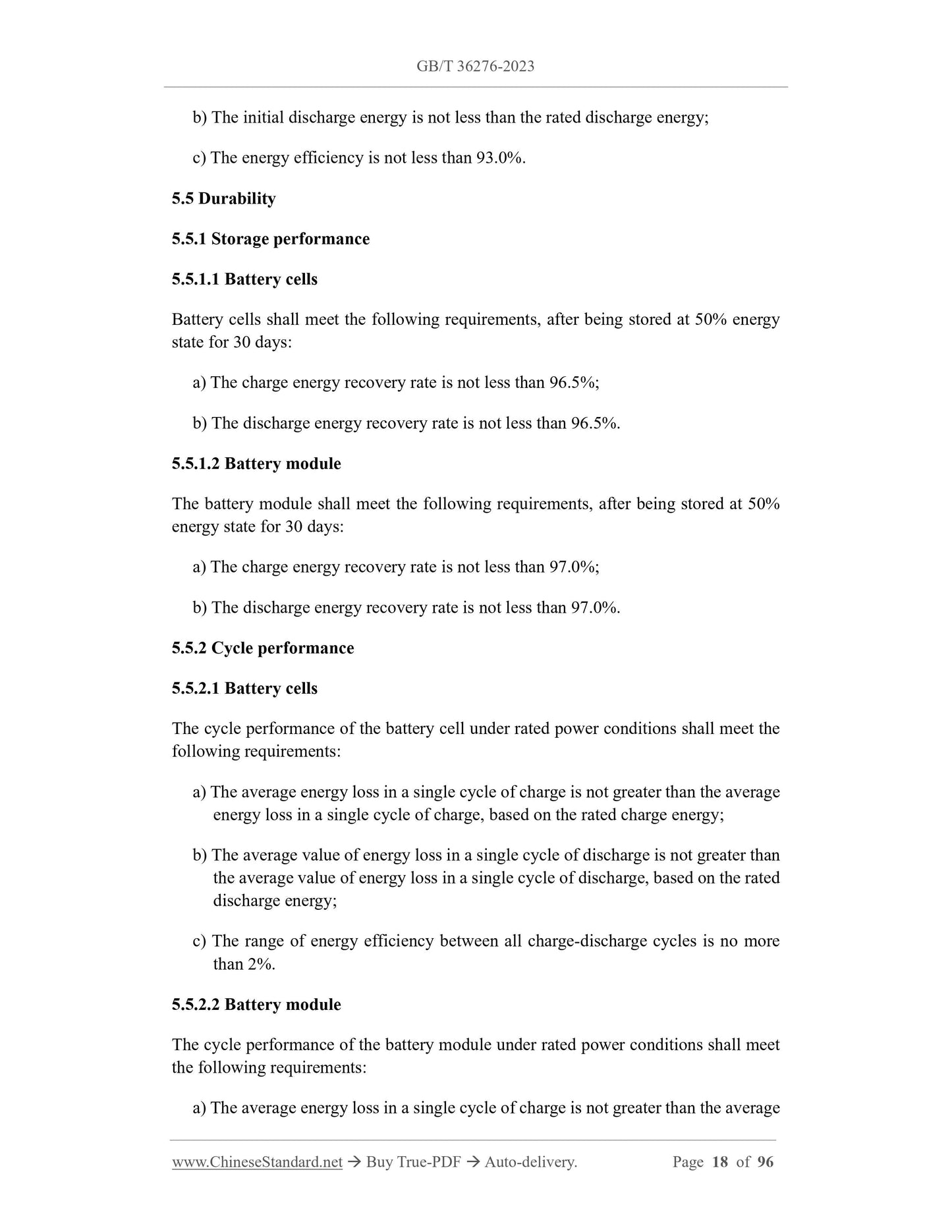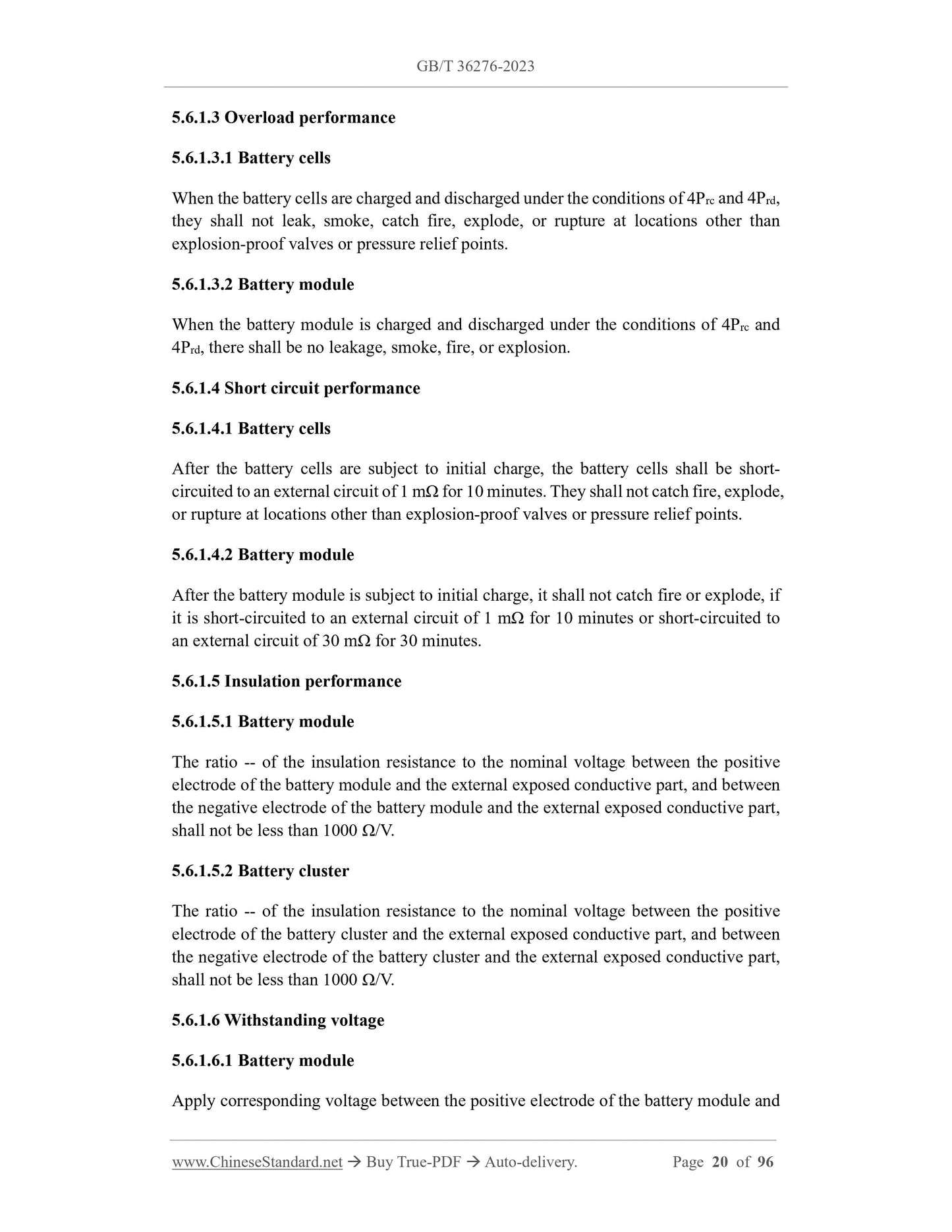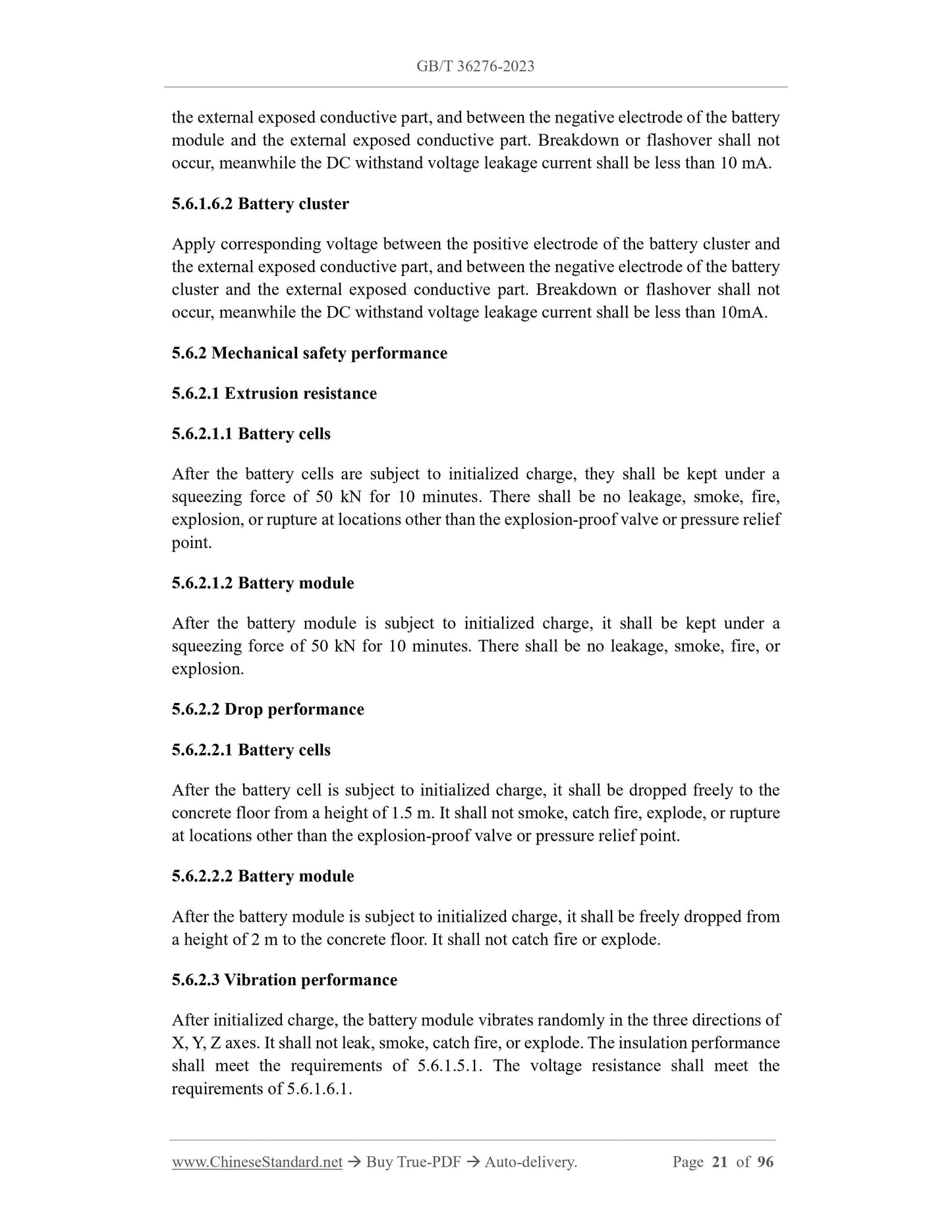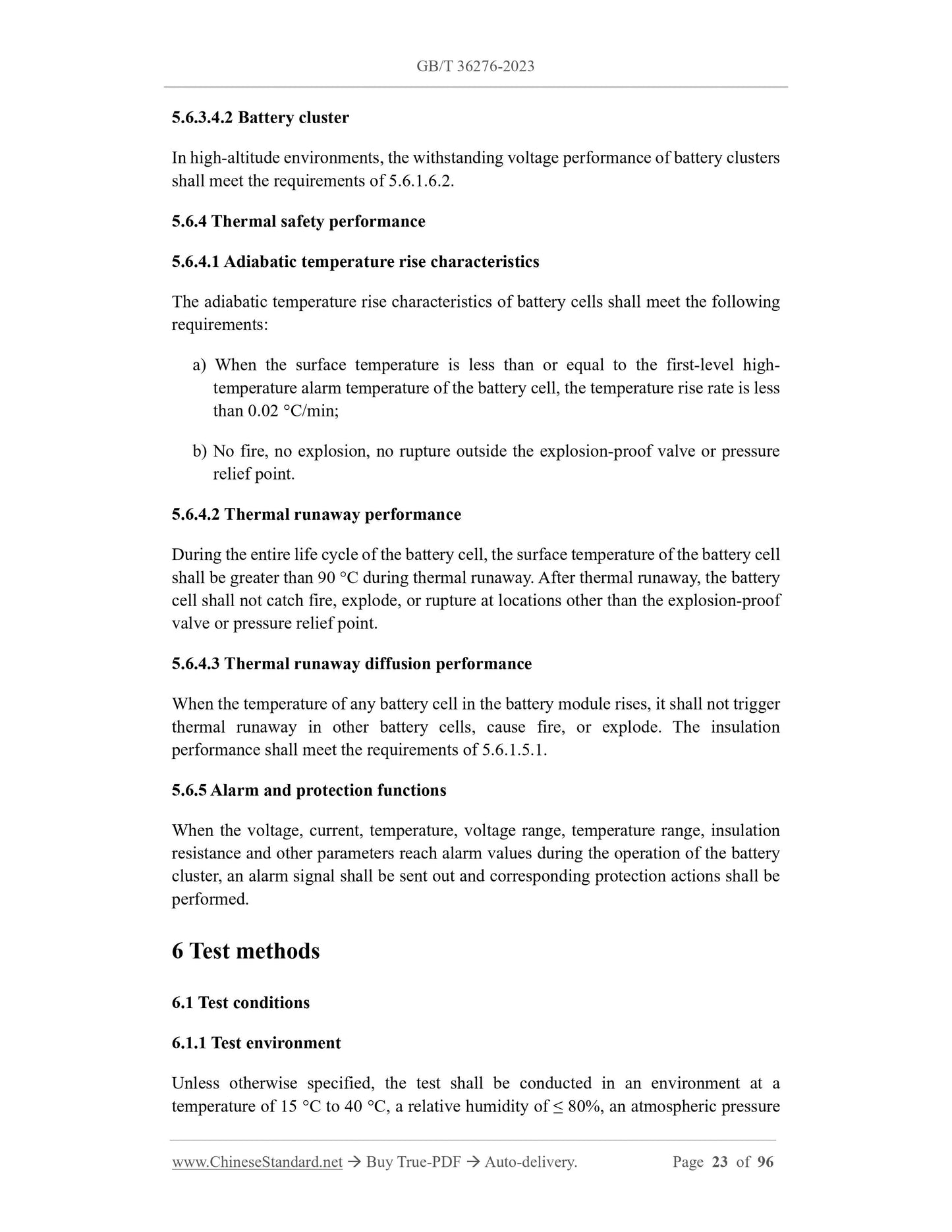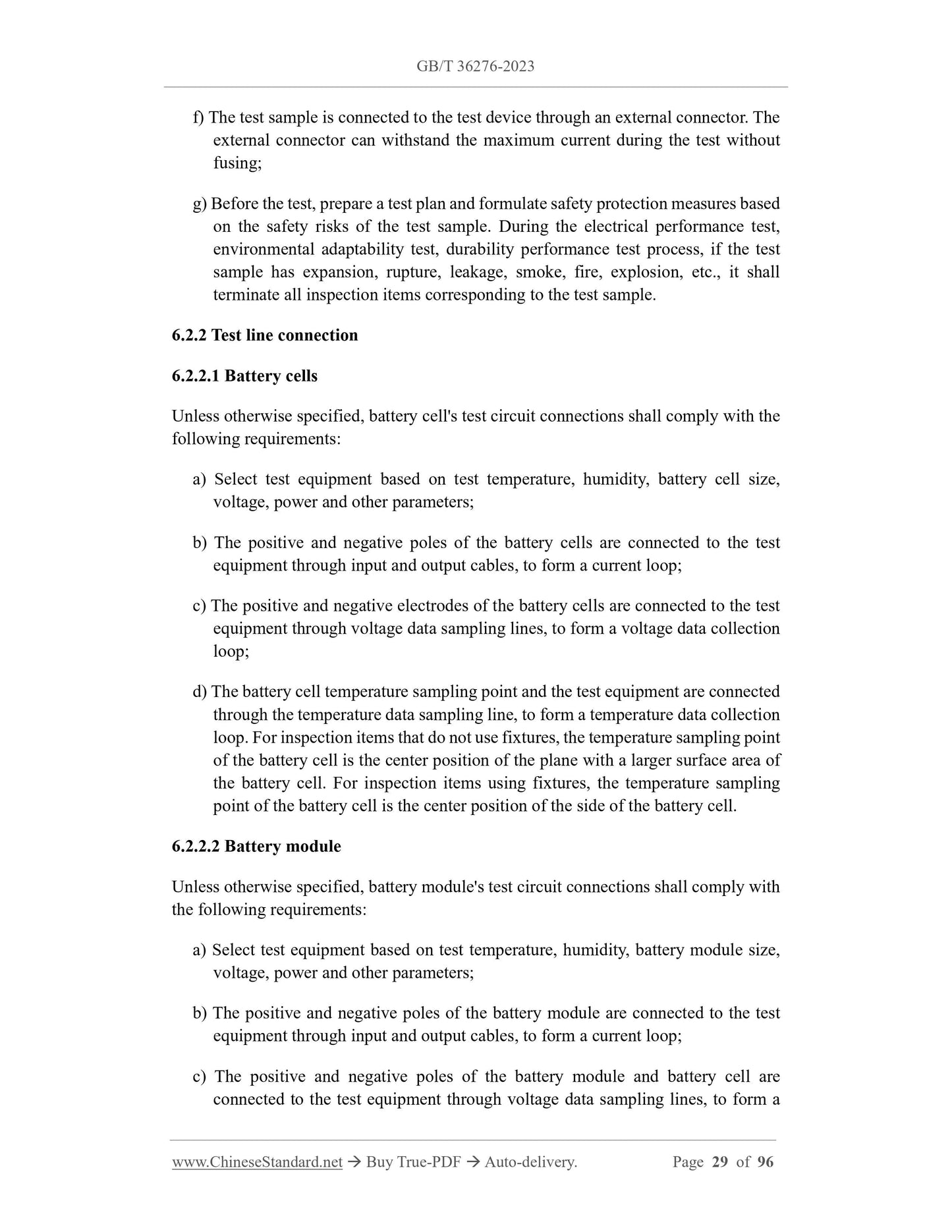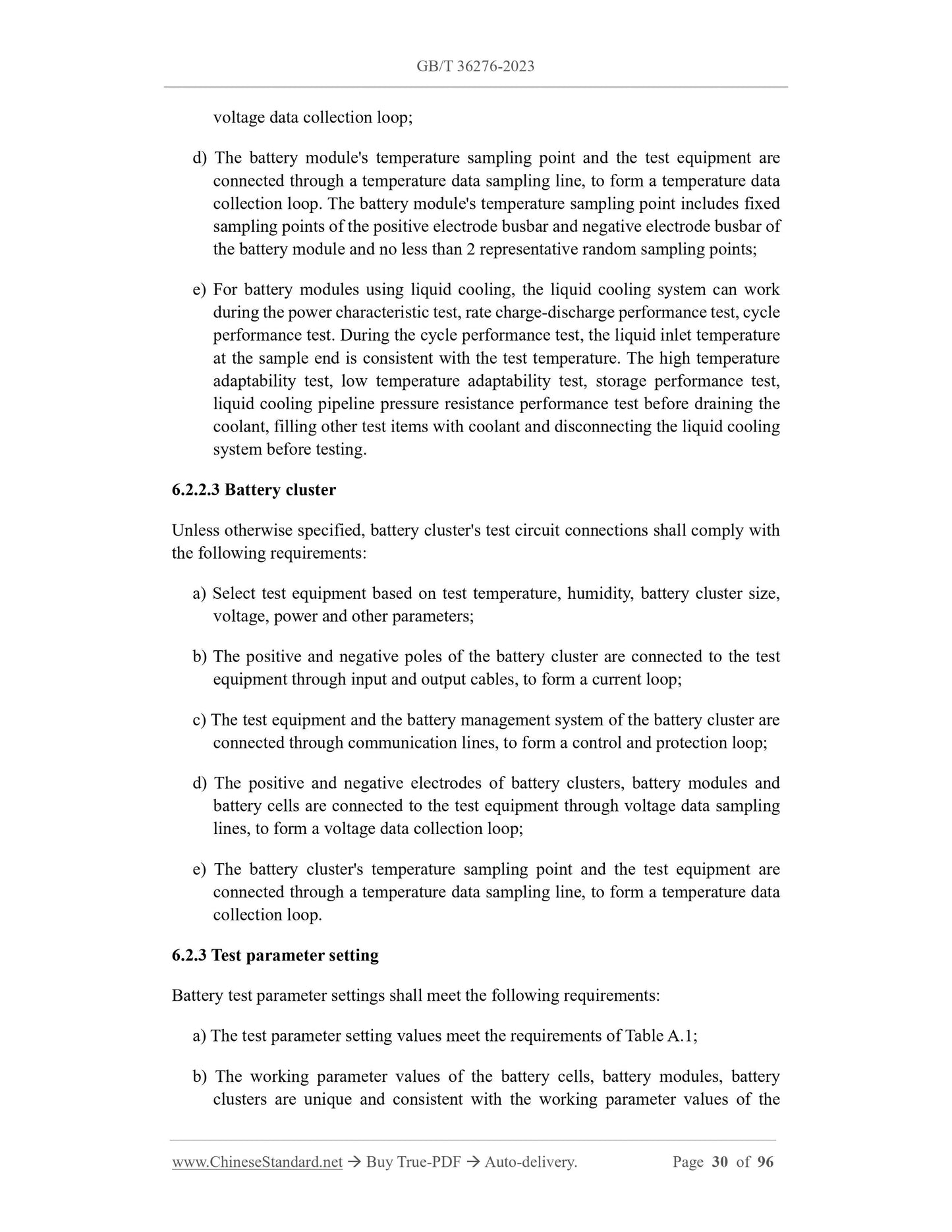1
/
von
12
PayPal, credit cards. Download editable-PDF and invoice in 1 second!
GB/T 36276-2023 English PDF (GBT36276-2023)
GB/T 36276-2023 English PDF (GBT36276-2023)
Normaler Preis
$815.00 USD
Normaler Preis
Verkaufspreis
$815.00 USD
Grundpreis
/
pro
Versand wird beim Checkout berechnet
Verfügbarkeit für Abholungen konnte nicht geladen werden
Delivery: 3 seconds. Download true-PDF + Invoice.
Get QUOTATION in 1-minute: Click GB/T 36276-2023
Historical versions: GB/T 36276-2023
Preview True-PDF (Reload/Scroll if blank)
GB/T 36276-2023: Lithium ion battery for electrical energy storage
GB/T 36276-2023
GB
NATIONAL STANDARD OF THE
PEOPLE’S REPUBLIC OF CHINA
ICS 27.180
CCS F 19
Replacing GB/T 36276-2018
Lithium ion battery for electrical energy storage
ISSUED ON: DECEMBER 28, 2023
IMPLEMENTED ON: JULY 01, 2024
Issued by: State Administration for Market Regulation;
Standardization Administration of PRC.
Table of Contents
Foreword ... 3
1 Scope ... 7
2 Normative references ... 7
3 Terms, definitions, symbols... 7
4 Encoding ... 10
5 Technical requirements ... 12
6 Test methods ... 23
7 Inspection rules ... 76
8 Marking, packaging, transportation, storage ... 84
Appendix A (Normative) Battery operating parameters ... 86
Appendix B (Informative) Battery specification parameters ... 90
Lithium ion battery for electrical energy storage
1 Scope
This document specifies the appearance, size and mass, electrical performance,
environmental adaptability, durability performance, safety performance and other
requirements of lithium-ion batteries for electric energy storage (referred to as "lithium-
ion batteries"); describes the corresponding test methods; stipulates coding, normal
working environment, inspection rules, marking, packaging, transportation and storage,
etc.
This document applies to the design, manufacturing, testing, inspection, operation,
maintenance, and overhaul of lithium-ion batteries for electrical energy storage.
2 Normative references
The contents of the following documents constitute essential provisions of this
document through normative references in the text. Among them, for dated reference
documents, only the version corresponding to the date applies to this document; for
undated reference documents, the latest version (including all amendments) applies to
this document.
GB/T 191 Packaging - Pictorial marking for handling of goods
GB/T 2828.1 Sampling procedures for inspection by attributes - Part1:Sampling
schemes indexed by acceptance quality limit (AQL) for lot-by-lot inspection
GB/T 4857 (all parts) Packaging - Transport packages
GB/T 5398 Test methods for large transport packages
GB/T 16471 Dimensional and weight constraints for transport package
DL/T 2528 Basic terminology of electric energy storage
3 Terms, definitions, symbols
3.1 Terms and definitions
The terms and definitions as defined in DL/T 2528, as well as the following terms and
definitions, apply to this document.
f) The initial charge energy range is not greater than 4.0% of the average initial
charge energy under 25 °C;
g) The initial discharge energy range is not greater than 4.0% of the average initial
discharge energy under 25 °C.
5.3.1.2 Battery module
The initial charge-discharge performance of the battery module under rated power
conditions shall meet the following requirements:
a) The initial charge energy is not less than the rated charge energy;
b) The initial discharge energy is not less than the rated discharge energy;
c) The initial charge-discharge energy efficiency is not less than 85.0% under 5 °C;
d) The initial charge-discharge energy efficiency is not less than 94.0% under 25 °C;
e) The initial charge-discharge energy efficiency is not less than 94.0% under 45 °C;
f) The initial charge energy range is not greater than 4.5% of the average initial
charge energy under 25 °C;
g) The initial discharge energy range is not greater than 4.5% of the average initial
discharge energy under 25 °C.
5.3.1.3 Battery cluster
The initial charge-discharge performance of the battery cluster under rated power
conditions shall meet the following requirements:
a) The initial charge energy is not less than the rated charge energy;
b) The initial discharge energy is not less than the rated discharge energy;
c) The initial charge-discharge energy efficiency is not less than 95.0%;
d) The battery cell voltage range at the end of charge is not greater than 250 mV;
e) The battery cell voltage range at the end of discharge is not greater than 300 mV;
f) The temperature range of the battery cells at the end of charge shall not be greater
than 6 °C;
g) The temperature range of the battery cells at the end of discharge shall not be
greater than 6 °C;
h) The voltage range of the battery module at the end of charge is not greater than
5.0% of the nominal voltage of the battery module;
i) The voltage range of the battery module at the end of discharge shall not be greater
than 5.0% of the nominal voltage of the battery module.
5.3.2 Power characteristics
5.3.2.1 Battery cells
The power characteristics of the battery cell shall meet the following requirements:
a) The charge energy under different charge-discharge powers is not less than the
rated charge energy;
b) The discharge energy under different charge-discharge powers is not less than the
rated discharge energy;
c) The energy efficiency under different charge-discharge powers is not less than
93.0%.
5.3.2.2 Battery module
Battery module power characteristics shall meet the following requirements:
a) The charge energy under different charge-discharge powers is not less than the
rated charge energy;
b) The discharge energy under different charge-discharge powers is not less than the
rated discharge energy;
c) The energy efficiency under different charge-discharge powers is not less than
94.0%.
5.3.3 Rate charge-discharge performance
5.3.3.1 Battery cells
The battery cell's rate charge-discharge performance shall meet the following
requirements:
a) The energy retention rate of 2Prc charge energy, as relative to Prc charge energy, is
not less than 95.0%;
b) The energy retention rate of 2Prd discharge energy, as relative to Prd discharge
energy, is not less than 95.0%;
c) The energy efficiency of constant power charge-discharge of 2Prc and 2Prd is not
less than 90.0%.
b) The discharge energy is not less than the rated discharge energy;
c) Energy efficiency is not less than 93.0%.
5.4.1.2 Battery module
The charge-discharge performance of the battery module, after returning to room
temperature from a high temperature environment, shall meet the following
requirements:
a) The charge energy is not less than the rated charge energy;
b) The discharge energy is not less than the rated discharge energy;
c) Energy efficiency is not less than 94.0%.
5.4.2 Low temperature adaptability
5.4.2.1 Battery cells
The charge-discharge performance of the battery cell, after returning to room
temperature from a low temperature environment, shall meet the following
requirements:
a) The charge energy is not less than the rated charge energy;
b) The discharge energy is not less than the rated discharge energy;
c) The energy efficiency is not less than 93.0%.
5.4.2.2 Battery module
The charge-discharge performance of the battery module, after returning to room
temperature from a low temperature environment, shall meet the following
requirements:
a) The charge energy is not less than the rated charge energy;
b) The discharge energy is not less than the rated discharge energy;
c) The energy efficiency is not less than 94.0%.
5.4.3 Initial charge-discharge performance at high altitude
In high-altitude environments, the initial charge-discharge performance of battery cells
under rated power conditions shall meet the following requirements:
a) The initial charge energy is not less than the rated charge energy;
b) The initial discharge energy is not less than the rated ...
Get QUOTATION in 1-minute: Click GB/T 36276-2023
Historical versions: GB/T 36276-2023
Preview True-PDF (Reload/Scroll if blank)
GB/T 36276-2023: Lithium ion battery for electrical energy storage
GB/T 36276-2023
GB
NATIONAL STANDARD OF THE
PEOPLE’S REPUBLIC OF CHINA
ICS 27.180
CCS F 19
Replacing GB/T 36276-2018
Lithium ion battery for electrical energy storage
ISSUED ON: DECEMBER 28, 2023
IMPLEMENTED ON: JULY 01, 2024
Issued by: State Administration for Market Regulation;
Standardization Administration of PRC.
Table of Contents
Foreword ... 3
1 Scope ... 7
2 Normative references ... 7
3 Terms, definitions, symbols... 7
4 Encoding ... 10
5 Technical requirements ... 12
6 Test methods ... 23
7 Inspection rules ... 76
8 Marking, packaging, transportation, storage ... 84
Appendix A (Normative) Battery operating parameters ... 86
Appendix B (Informative) Battery specification parameters ... 90
Lithium ion battery for electrical energy storage
1 Scope
This document specifies the appearance, size and mass, electrical performance,
environmental adaptability, durability performance, safety performance and other
requirements of lithium-ion batteries for electric energy storage (referred to as "lithium-
ion batteries"); describes the corresponding test methods; stipulates coding, normal
working environment, inspection rules, marking, packaging, transportation and storage,
etc.
This document applies to the design, manufacturing, testing, inspection, operation,
maintenance, and overhaul of lithium-ion batteries for electrical energy storage.
2 Normative references
The contents of the following documents constitute essential provisions of this
document through normative references in the text. Among them, for dated reference
documents, only the version corresponding to the date applies to this document; for
undated reference documents, the latest version (including all amendments) applies to
this document.
GB/T 191 Packaging - Pictorial marking for handling of goods
GB/T 2828.1 Sampling procedures for inspection by attributes - Part1:Sampling
schemes indexed by acceptance quality limit (AQL) for lot-by-lot inspection
GB/T 4857 (all parts) Packaging - Transport packages
GB/T 5398 Test methods for large transport packages
GB/T 16471 Dimensional and weight constraints for transport package
DL/T 2528 Basic terminology of electric energy storage
3 Terms, definitions, symbols
3.1 Terms and definitions
The terms and definitions as defined in DL/T 2528, as well as the following terms and
definitions, apply to this document.
f) The initial charge energy range is not greater than 4.0% of the average initial
charge energy under 25 °C;
g) The initial discharge energy range is not greater than 4.0% of the average initial
discharge energy under 25 °C.
5.3.1.2 Battery module
The initial charge-discharge performance of the battery module under rated power
conditions shall meet the following requirements:
a) The initial charge energy is not less than the rated charge energy;
b) The initial discharge energy is not less than the rated discharge energy;
c) The initial charge-discharge energy efficiency is not less than 85.0% under 5 °C;
d) The initial charge-discharge energy efficiency is not less than 94.0% under 25 °C;
e) The initial charge-discharge energy efficiency is not less than 94.0% under 45 °C;
f) The initial charge energy range is not greater than 4.5% of the average initial
charge energy under 25 °C;
g) The initial discharge energy range is not greater than 4.5% of the average initial
discharge energy under 25 °C.
5.3.1.3 Battery cluster
The initial charge-discharge performance of the battery cluster under rated power
conditions shall meet the following requirements:
a) The initial charge energy is not less than the rated charge energy;
b) The initial discharge energy is not less than the rated discharge energy;
c) The initial charge-discharge energy efficiency is not less than 95.0%;
d) The battery cell voltage range at the end of charge is not greater than 250 mV;
e) The battery cell voltage range at the end of discharge is not greater than 300 mV;
f) The temperature range of the battery cells at the end of charge shall not be greater
than 6 °C;
g) The temperature range of the battery cells at the end of discharge shall not be
greater than 6 °C;
h) The voltage range of the battery module at the end of charge is not greater than
5.0% of the nominal voltage of the battery module;
i) The voltage range of the battery module at the end of discharge shall not be greater
than 5.0% of the nominal voltage of the battery module.
5.3.2 Power characteristics
5.3.2.1 Battery cells
The power characteristics of the battery cell shall meet the following requirements:
a) The charge energy under different charge-discharge powers is not less than the
rated charge energy;
b) The discharge energy under different charge-discharge powers is not less than the
rated discharge energy;
c) The energy efficiency under different charge-discharge powers is not less than
93.0%.
5.3.2.2 Battery module
Battery module power characteristics shall meet the following requirements:
a) The charge energy under different charge-discharge powers is not less than the
rated charge energy;
b) The discharge energy under different charge-discharge powers is not less than the
rated discharge energy;
c) The energy efficiency under different charge-discharge powers is not less than
94.0%.
5.3.3 Rate charge-discharge performance
5.3.3.1 Battery cells
The battery cell's rate charge-discharge performance shall meet the following
requirements:
a) The energy retention rate of 2Prc charge energy, as relative to Prc charge energy, is
not less than 95.0%;
b) The energy retention rate of 2Prd discharge energy, as relative to Prd discharge
energy, is not less than 95.0%;
c) The energy efficiency of constant power charge-discharge of 2Prc and 2Prd is not
less than 90.0%.
b) The discharge energy is not less than the rated discharge energy;
c) Energy efficiency is not less than 93.0%.
5.4.1.2 Battery module
The charge-discharge performance of the battery module, after returning to room
temperature from a high temperature environment, shall meet the following
requirements:
a) The charge energy is not less than the rated charge energy;
b) The discharge energy is not less than the rated discharge energy;
c) Energy efficiency is not less than 94.0%.
5.4.2 Low temperature adaptability
5.4.2.1 Battery cells
The charge-discharge performance of the battery cell, after returning to room
temperature from a low temperature environment, shall meet the following
requirements:
a) The charge energy is not less than the rated charge energy;
b) The discharge energy is not less than the rated discharge energy;
c) The energy efficiency is not less than 93.0%.
5.4.2.2 Battery module
The charge-discharge performance of the battery module, after returning to room
temperature from a low temperature environment, shall meet the following
requirements:
a) The charge energy is not less than the rated charge energy;
b) The discharge energy is not less than the rated discharge energy;
c) The energy efficiency is not less than 94.0%.
5.4.3 Initial charge-discharge performance at high altitude
In high-altitude environments, the initial charge-discharge performance of battery cells
under rated power conditions shall meet the following requirements:
a) The initial charge energy is not less than the rated charge energy;
b) The initial discharge energy is not less than the rated ...
Share
